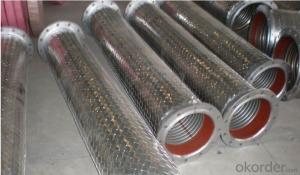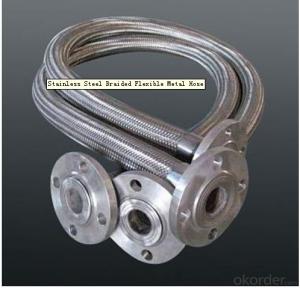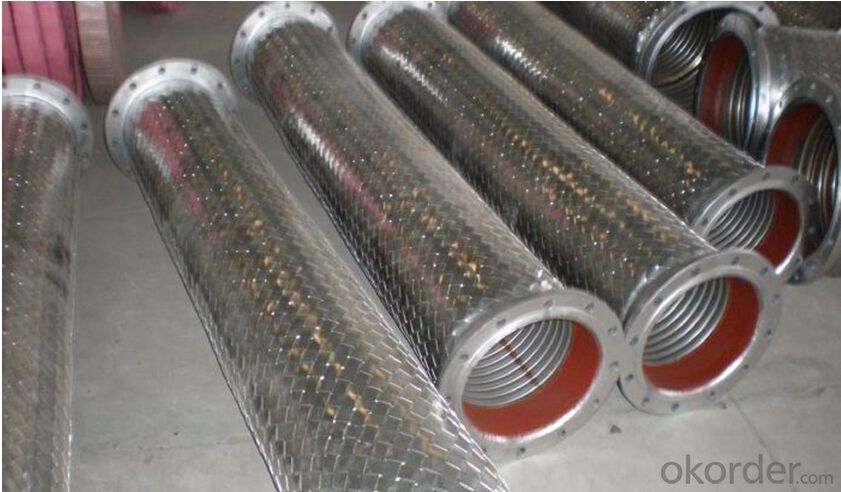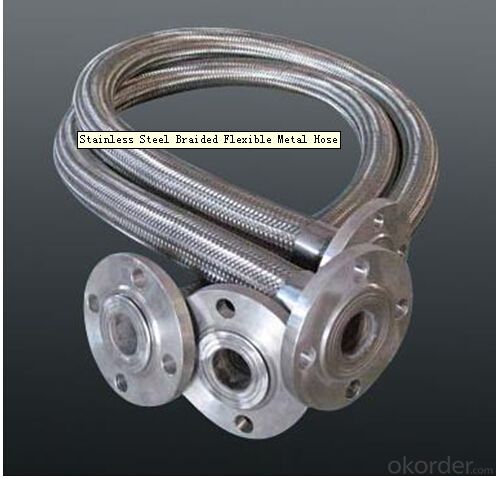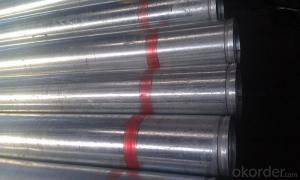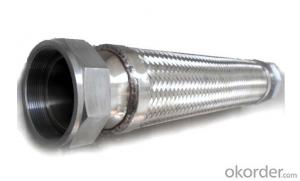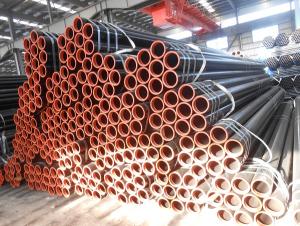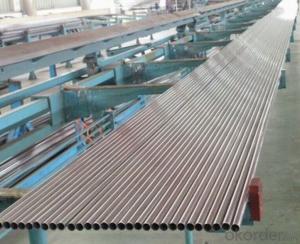Metal Hose in Stainless Steel for Gas Transportation
- Loading Port:
- Tianjin
- Payment Terms:
- TT OR LC
- Min Order Qty:
- 1000 pc
- Supply Capability:
- 100000 pc/month
OKorder Service Pledge
OKorder Financial Service
You Might Also Like
Specification
Metal Hose in Stainless Steel for Gas Transportation
Applications of Metal Hose in Stainless Steel for Gas Transportation:
--Refueling system
--Chemical and pharmaceutical industry
--Industrial hydraulic systems
--Air conditioners in industrial and construction –site vehicles
--Food and beverage industry
--Special and standard industrial applications
--Water and cleaning management
Features of Metal Hose in Stainless Steel for Gas Transportation:
1. )O. D.: 13-18MM 0.2-3M long
2. )Nut.: Nickel/Chrome Plated Brass (Zinc / Iron / Aluminum is available)
3. )Size Of Nut.: Female&Male 1/2''; 3/4''; 3/8''; 7/8''; 5/16'', and M10...
4. )Insert.: Brass (Zinc / Aluminum / Plastic is available)
5. )Inner tube.: Rubber/ EPDM/PVC
6. )Covered Material: Stainless Steel 201, 301, 304 /Aluminium Wire
7. )Working Pressure: 5Kg-15Kg
8. )Temperature: 0-92° C
9. )Quality Assurance: 3 years
RemarkAPPLICATION: HOUSEEHOLD WARE, BATHROOM WARE, SHOWER HOSE
PAYMENT: T/T, L/C
DELIVERY TIME: 20DAYS OR 30DAYS AFTER RECEIVED 30% DEPOSITS
MOQ: 5000PCS
ODM&OEM IS ACCEPTABLE
PackageInner: PP bag /Blister packing Outer: Carton box
Specifications of Metal Hose in Stainless Steel for Gas Transportation:
NO | I.D | Refer to O.D | Working pressure | Burst pressure | approximate Weight | |||||
(inch) | (mm) | (inch) | (mm) | MPa | Psi | MPa | Psi | kg/m | lbs/ft | |
1 | 1/8 | 3.2±0.2 | 0.35 | 9±0.3 | 2.06 | 300 | 8.27 | 1200 | 0.078 | 0.12 |
2 | 5/32 | 4±0.2 | 0.4 | 10±0.3 | 2.06 | 300 | 8.27 | 1200 | 0.092 | 0.14 |
3 | 3/16 | 4.8±0.2 | 0.43 | 11±0.3 | 2.06 | 300 | 8.27 | 1200 | 0.108 | 0.16 |
4 | 1/4 | 6.3±0.3 | 0.5 | 12.7±0.3 | 2.06 | 300 | 8.27 | 1200 | 0.134 | 0.2 |
5 | 5/16 | 8.0±0.3 | 0.56 | 14±0.3 | 2.06 | 300 | 8.27 | 1200 | 0.147 | 0.22 |
6 | 3/8 | 9.5±0.3 | 0.63 | 16±0.4 | 2.06 | 300 | 8.27 | 1200 | 0.182 | 0.27 |
7 | 15/32 | 12±0.3 | 0.75 | 19±0.5 | 2.06 | 300 | 8.27 | 1200 | 0.238 | 0.35 |
8 | 1/2 | 12.7±0.4 | 0.78 | 20±0.5 | 2.06 | 300 | 8.27 | 1200 | 0.262 | 0.39 |
9 | 5/8 | 16±0.4 | 0.94 | 24±0.5 | 1.03 | 150 | 4.12 | 600 | 0.351 | 0.52 |
10 | 3/4 | 19±0.4 | 1.13 | 28.8±0.5 | 1.03 | 150 | 4.12 | 600 | 0.515 | 0.77 |
11 | 1 | 25.4±0.5 | 1.38 | 35±0.6 | 1.03 | 150 | 4.12 | 600 | 0.637 | 0.95 |
Images of Metal Hose in Stainless Steel for Gas Transportation:
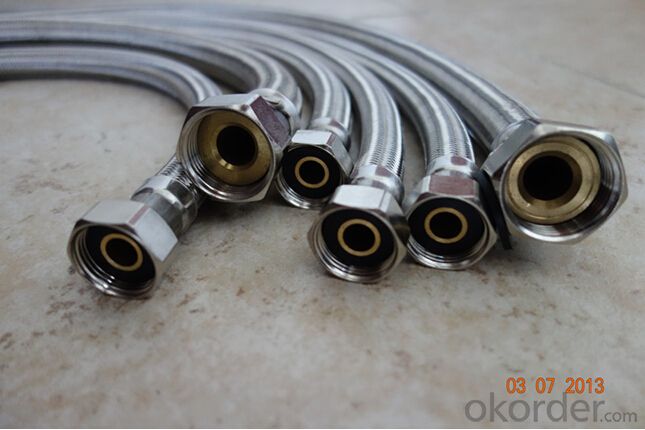
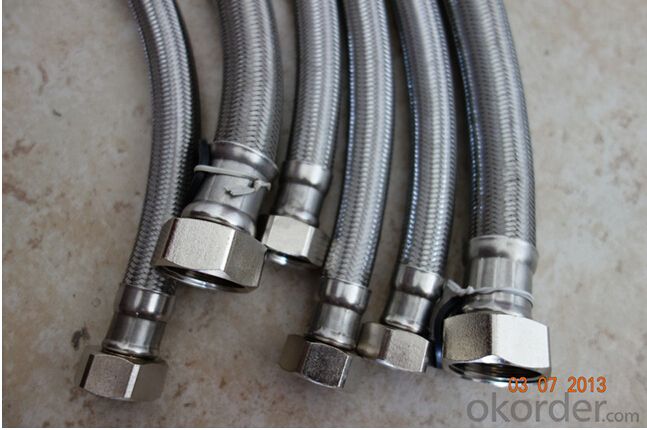
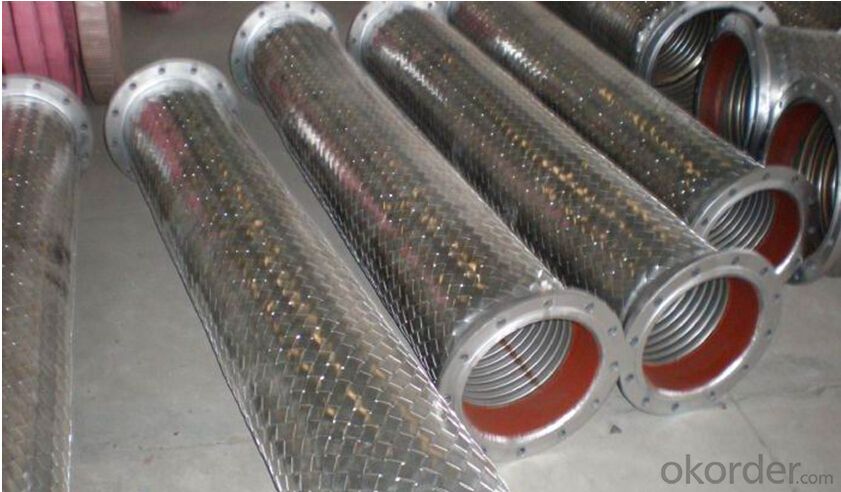
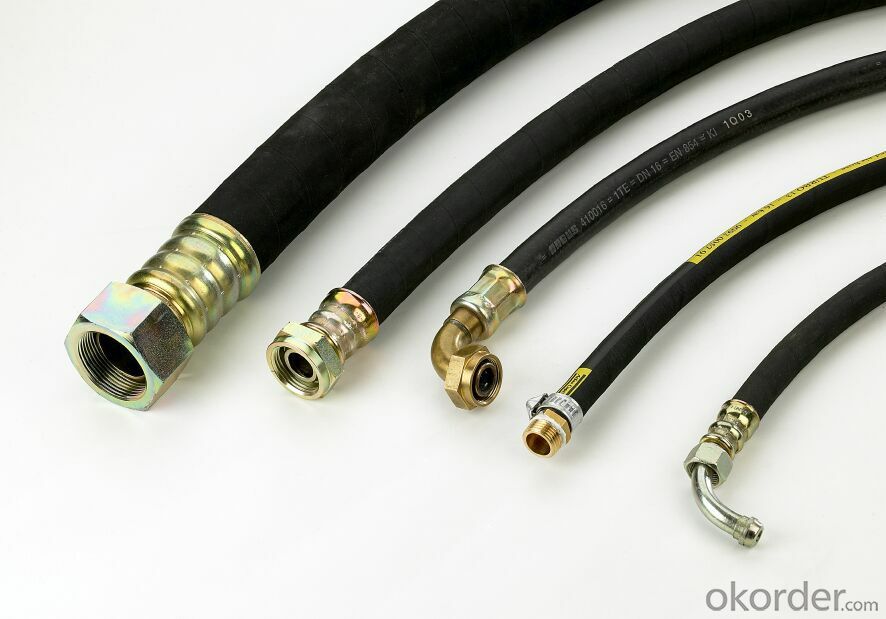
Package of Metal Hose in Stainless Steel for Gas Transportation:
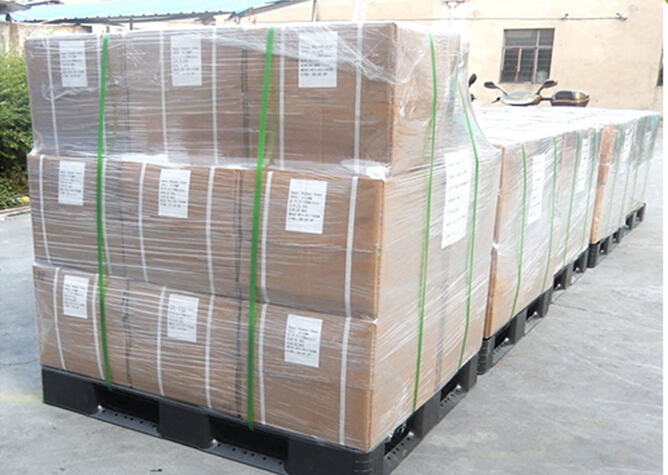

FAQ of Metal Hose in Stainless Steel for Gas Transportation:
Who we are:
Answer: We CNBM is a Chinese state-owned enterprise ranked 267th among the Global Fortune 500, as the largest building materials company,we have over 300 affiliated companies,and so many production lines and branch office distribute in China.
2. About our quality:
Answer: Every product needs to be quality proved before shipping.
3. About our service:
Answer: We could gurantte that we can reply you in 2 working hours.
- Q: What are the different types of stainless steel pipe couplings?
- There are several different types of stainless steel pipe couplings available in the market, each offering unique features and functionalities. Some of the common types include: 1. Compression couplings: These couplings are designed to provide a tight and secure connection by compressing the pipe ends together using a compression nut. They are easy to install and suitable for both rigid and flexible pipe systems. 2. Flanged couplings: These couplings have flanges on both ends, which can be bolted together to create a strong and leak-proof connection. Flanged couplings are commonly used in industrial applications where high pressures and temperatures are involved. 3. Grooved couplings: These couplings consist of two segments that grip the pipe ends when tightened, creating a reliable and flexible connection. They are often used in fire protection systems and HVAC applications due to their ease of installation and ability to withstand vibration and movement. 4. Threaded couplings: As the name suggests, these couplings have threads on the inside, allowing them to be screwed onto the pipe ends. They are commonly used in low-pressure applications and are easy to assemble and disassemble. 5. Quick connect couplings: These couplings feature a quick-connect mechanism that allows for easy and rapid installation without the need for tools or additional components. They are often used in plumbing and irrigation systems. 6. Welded couplings: These couplings require the pipe ends to be welded together to create a permanent and robust connection. They are commonly used in high-pressure and high-temperature applications where a strong joint is essential. It is important to select the appropriate type of stainless steel pipe coupling based on the specific requirements of the application, such as the operating conditions, pipe material, and system design. Consulting with a professional or referring to industry standards can help ensure the right choice is made.
- Q: How do stainless steel pipes compare to fiberglass-reinforced pipes?
- Both stainless steel pipes and fiberglass-reinforced pipes are popular options for a range of uses. However, they possess distinct qualities that differentiate them from each other. To begin with, stainless steel pipes are renowned for their exceptional durability and strength. They can endure high pressure, temperature, and corrosion, making them suitable for industrial and heavy-duty applications such as oil and gas, chemical processing, and plumbing systems. Additionally, stainless steel pipes are non-combustible and have a lengthy lifespan, reducing the need for frequent replacements. In contrast, fiberglass-reinforced pipes (FRP) offer unique advantages in specific circumstances. FRP pipes are lightweight and possess excellent chemical resistance, making them ideal for use in corrosive environments like wastewater treatment plants, desalination facilities, and chemical processing plants. Moreover, FRP pipes outperform stainless steel pipes in terms of insulation properties, which can be advantageous in situations requiring thermal insulation. In terms of cost, stainless steel pipes generally carry a higher price tag compared to fiberglass-reinforced pipes. However, it is crucial to consider the project's specific requirements and the expected lifespan of the pipes when assessing overall cost-effectiveness. Ultimately, the choice between stainless steel pipes and fiberglass-reinforced pipes hinges on the particular needs of the application. If durability, strength, and resistance to high pressure and temperature are the primary considerations, stainless steel pipes are the preferred option. Conversely, if factors such as weight, corrosion resistance, and insulation properties take precedence, fiberglass-reinforced pipes may prove to be the superior choice.
- Q: What are the different types of stainless steel pipe coatings?
- There are several types of stainless steel pipe coatings that are used to enhance the durability, corrosion resistance, and aesthetic appearance of the pipes. Some of the common types of stainless steel pipe coatings include: 1. Fusion Bonded Epoxy (FBE) Coating: FBE coating is a thermosetting resin-based coating that is applied to the pipes using an electrostatic spray. It provides excellent corrosion resistance and adhesion, making it suitable for both buried and above-ground applications. 2. Polyethylene (PE) Coating: PE coating is a thermoplastic coating that is applied to the pipes using extrusion. It provides high impact resistance and excellent resistance to chemical substances, making it suitable for pipes used in harsh environments. 3. Polypropylene (PP) Coating: PP coating is a thermoplastic coating similar to PE coating but with higher temperature resistance. It is often used for pipes that transport high-temperature fluids. 4. Polyurethane (PU) Coating: PU coating is a thermosetting resin-based coating that is applied to the pipes using a spray or dip method. It provides excellent resistance to abrasion, impact, and chemicals, making it suitable for pipes used in demanding applications. 5. Zinc Coating: Zinc coating, also known as galvanization, is a metallic coating that is applied to the pipes using a hot-dip process. It provides excellent corrosion resistance and is commonly used for pipes used in outdoor and underground applications. 6. Ceramic Coating: Ceramic coating is a high-temperature resistant coating that is applied to the pipes using a thermal spray process. It provides excellent resistance to abrasion, oxidation, and corrosion, making it suitable for pipes used in high-temperature environments. 7. PTFE (Polytetrafluoroethylene) Coating: PTFE coating is a non-stick coating that is applied to the pipes using a spray or dip method. It provides excellent resistance to chemicals and high temperatures, making it suitable for pipes used in the chemical and food industries. These are just a few examples of the different types of stainless steel pipe coatings available. The choice of coating depends on the specific requirements of the application, such as the type of fluid being transported, the operating temperature and pressure, and the environmental conditions.
- Q: Can stainless steel pipes be used for wastewater treatment plants?
- Yes, stainless steel pipes can be used for wastewater treatment plants. Stainless steel is highly resistant to corrosion and can withstand the harsh and corrosive environment of wastewater treatment plants. It is a durable and reliable material that can effectively transport and handle wastewater without degradation or contamination.
- Q: What is the difference between 304J3 and 316J3 stainless steel pipes?
- The main difference between 304J3 and 316J3 stainless steel pipes is their composition and corrosion resistance. 304J3 stainless steel contains a higher percentage of chromium and nickel, making it more resistant to corrosion in various environments. On the other hand, 316J3 stainless steel contains molybdenum in addition to chromium and nickel, providing even greater resistance to corrosion, especially in chloride-rich environments. Therefore, while both are suitable for general applications, 316J3 stainless steel pipes are ideal for more demanding and corrosive conditions.
- Q: Can stainless steel pipes be used for transportation of hazardous materials?
- Indeed, hazardous materials can be transported using stainless steel pipes. The reason for this is that stainless steel is renowned for its resistance to corrosion, its strength, and its durability, all of which make it appropriate for handling various types of hazardous substances. In industries such as chemicals, petrochemicals, oil and gas, and pharmaceuticals, where the transportation of hazardous materials is a routine occurrence, stainless steel pipes are frequently employed. The corrosion resistance of stainless steel ensures that it can endure exposure to a wide range of chemicals without deteriorating. This is particularly crucial when transporting hazardous materials that have the potential to react with or corrode other materials. Moreover, stainless steel pipes possess high strength, enabling them to withstand the pressures and stresses associated with the transportation of hazardous materials. Furthermore, stainless steel pipes can maintain the integrity of the hazardous material being transported by preventing contamination from external sources. Stainless steel, being inert and having a smooth surface, is resistant to the formation of deposits that could potentially react with or contaminate the hazardous materials. However, it is worth noting that careful consideration should be given to the selection of the appropriate stainless steel grade and its compatibility with the specific hazardous material being transported. Different stainless steel alloys possess distinct characteristics, so it is crucial to choose the grade that can withstand the specific chemical properties of the hazardous material. Additionally, it is always important to adhere to regulations and standards governing the transportation of hazardous materials in order to ensure safety and compliance. These regulations may include specific requirements regarding the design, fabrication, and testing of the stainless steel pipes used for transportation. To conclude, stainless steel pipes can effectively be employed for the transportation of hazardous materials due to their corrosion resistance, strength, and durability. However, it is vital to consider the specific requirements of the hazardous material and to adhere to relevant regulations to ensure the safe and efficient transportation of such materials.
- Q: Can stainless steel pipes be used for chemical laboratories?
- Yes, stainless steel pipes can be used for chemical laboratories. Stainless steel is highly resistant to corrosion and can withstand a wide range of chemicals and temperatures, making it an ideal material for handling and transporting various chemicals in a laboratory setting. It offers excellent durability, strength, and reliability, making it suitable for use in both standard and specialized laboratory applications. Additionally, stainless steel pipes are easy to clean and maintain, ensuring a hygienic and safe environment in the laboratory.
- Q: What is the maximum pressure rating for stainless steel pipes?
- The maximum pressure rating for stainless steel pipes can vary depending on factors such as the pipe size, wall thickness, and the specific grade of stainless steel used. However, stainless steel pipes are typically capable of handling high-pressure applications and can have maximum pressure ratings ranging from 1500 psi to 10,000 psi or more. It is important to refer to industry standards and consult with manufacturers to determine the exact maximum pressure rating for a specific stainless steel pipe.
- Q: What is the maximum length of a stainless steel pipe that can be manufactured?
- The maximum length of a stainless steel pipe that can be manufactured is typically determined by practical limitations such as transportation and handling capabilities. In general, stainless steel pipes can be manufactured in lengths ranging from a few feet to several hundred feet. However, the exact maximum length can vary depending on factors such as the diameter and thickness of the pipe, as well as the manufacturing capabilities of the specific company or facility. It is important to consult with the manufacturer or supplier to determine the maximum length available for a particular stainless steel pipe.
- Q: Are stainless steel pipes suitable for chemical refineries?
- Yes, stainless steel pipes are suitable for chemical refineries. Stainless steel is highly resistant to corrosion and can withstand extreme temperatures and pressures, making it an ideal choice for transporting various chemicals and fluids in refineries. Additionally, stainless steel pipes are durable, hygienic, and have a long lifespan, ensuring the safe and efficient operation of chemical refineries.
Send your message to us
Metal Hose in Stainless Steel for Gas Transportation
- Loading Port:
- Tianjin
- Payment Terms:
- TT OR LC
- Min Order Qty:
- 1000 pc
- Supply Capability:
- 100000 pc/month
OKorder Service Pledge
OKorder Financial Service
Similar products
Hot products
Hot Searches
Related keywords
